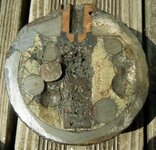BladeRunner2019
Hero Member
- Dec 22, 2013
- 744
- 1,774
- Detector(s) used
- XP Deus, Equinox 800
- Primary Interest:
- Metal Detecting
I recently found a 12 pound spherical shell with the fuse still intact. I'm looking into getting it disarmed and have gotten a couple different answers on where the person would drill. One said they would go through the fuse which is easier and it also doesn't leave a hole in the shell. The other person said they would drill the shell so they wouldn't mess up the fuse.
I kind of like the idea of not "messing up" the fuse, but I'm not sure which way I should go.
Any opinions on the subject would be appreciated.

I kind of like the idea of not "messing up" the fuse, but I'm not sure which way I should go.
Any opinions on the subject would be appreciated.


Upvote
0




